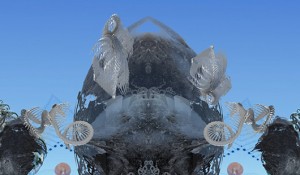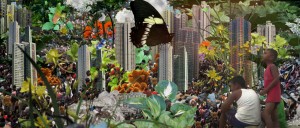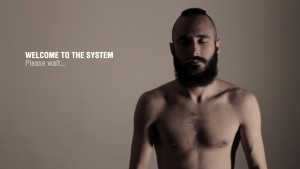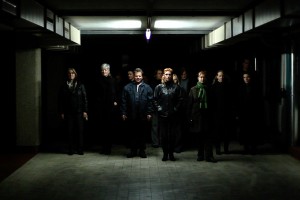Published by Alessandro Violante on March 25, 2016
 As always less often happens, above all in our geographical areas (mainly Italy), visiting the exhibition spaces of the Digital Flows exhibition (enjoyable from 5th March to 3rd April, from friday to sunday from 2 to 6 PM), presented by the Milan-based videoart platform Visualcontainer (formed by Alessandra Arnò and Paolo Simoni) and hosted inside the MACT / CACT spaces of Bellinzona, it seems to come back to the past, to recover a way of experiencing the fruition of the videoartistic oeuvre that too often seems to be relegated to art history books, in favor of that purely narrative approach that seems to dominate festivals (non all of them, this is true) and several exhibitions, in particular those focused on the work of certain artists that seem to be more interested in an idea of videoart more similar to the cinematographic one. This artistic switch has a role in hiding the enormous (and far from being explored in their totality) potentialities of this artistic language.
As always less often happens, above all in our geographical areas (mainly Italy), visiting the exhibition spaces of the Digital Flows exhibition (enjoyable from 5th March to 3rd April, from friday to sunday from 2 to 6 PM), presented by the Milan-based videoart platform Visualcontainer (formed by Alessandra Arnò and Paolo Simoni) and hosted inside the MACT / CACT spaces of Bellinzona, it seems to come back to the past, to recover a way of experiencing the fruition of the videoartistic oeuvre that too often seems to be relegated to art history books, in favor of that purely narrative approach that seems to dominate festivals (non all of them, this is true) and several exhibitions, in particular those focused on the work of certain artists that seem to be more interested in an idea of videoart more similar to the cinematographic one. This artistic switch has a role in hiding the enormous (and far from being explored in their totality) potentialities of this artistic language.
Above all during the late ’60s and during the ’70s, until, approximately, the mid ’80s, several were those artists that, often collaborating with engineers and technicians of various genres, gave shape and substance to their creativity and to their thought, sometimes, as in the case of Steina and Woody Vasulka or Lynn Hershman Leeson (among the others), not only having a primary role on the evolution of the artistic language, but also in that of technology, using, as in the Vasulka’s history, machines (that today we call devices) particularly new (at their time), whose results, consciously or not, we enjoy even today, and they were the primary influences for who, in those years, began to operate on the field of new media art, artists that often anticipated certain developments typical of our future (read, for example, our interview to to Monika Fleischmann and Wolfgang Strauss in FLUXES #2).
Digital Flows recovers the concept of digital flow, of non-cinematographic time, as theorized by Woody Vasulka, but rather of the time of analogic and then digital image, of the “real time”, always editable in real time (by means of the technique known as feedback), although the works enjoyable are digital videos whose life cycle has been written and it’s not editable.
In the case of the South Korea (and this isn’t casual) / America-based Hwayong Jung‘s Euphoria, the so called generative art, a sort of transverse artistic current of digital video art, recovers, thanks to the fractals randomly generated by an algorythm defined by the artist, the non-cinematographic space, the so called David Larcher‘s video void, an abstraction of reality that generates in us a thought and the entrance to a particular “other” dimenions, that is one of the more fascinating characteristics of the artist videoart and of videoart in wider terms.
The italian artist Barbara Brugola, in Lapse Of View, flirts with the cinematographic medium, using techniques also used by experimental movie directors (although always with an eye kept towards the narrative dimension of cinema) as Peter Greenaway, and in this artwork she plays with time and with counterposed dimensions. Here there’s also a focus on the medium, rather than on the narration of an event, a way of thinking videoart closer to that of videoart old masters.
In Panorama, Gianluca Abbate, if artistically is linked to the work of more recent artists, conceptually recovers the never faded dream of the panoramic vision that, thanks to the virtual art experiences of the ’90s, has known some of its best products. Here the artist doesn’t focus on a sensorial immersion, but on the thrust on the thought about the world that surround us and on the linkage between nature and urban development / technology, portraying very well the apparently typical contradictions of our society (to which we’re now used to).
The Lithuania-based artist Rimas Sakalauskas, in Synchronisation, works not much on the conceptual abstraction but on the hybridization between scenarios taken from the real world and on postproduced elaborations that create an uncommon effect, difficult to understand at first sight. To use terms close to the artistic developments of our epoch, here the artist works with the augmentation of reality and with the detachment, from the context, of the elements shown in the scenarios. Here the choice of using movie-like slow rhythms is estranging, rhythms that seem to represent the slow liberation from a weight that entangle us, and the viewer feels freed when these elements leave the artwork space.
Miguel Andres‘s System is a video that, rather clearly, make us think about the condition of the postmodern man programmed by a society that imposes him predetermined ways of thinking and of acting in the world, recovering the never too much explored conceptual universe of Wachowski brothers’s Matrix. A short but intense artwork.
There’s also the work the work of the Austria-based Katharina Gruzei, entitled Workers Leaving The Factory (Again), that, on the one hand, pays an obvious tribute to the famous “movie” of Lumière brothers, that strongly stirred the audience of the late XIX° century, and on the other hand has a linkage with Pellizza Da Volpedo‘s Il Quarto Stato (The Fourth State). Here, the alienating dimension of the most extreme capitalism is evoked, that want us to be machines with no identity, whose only goal is the production of products that, for the most part of them, have a short life cycle and don’t give us a concrete benefit, uniquely increasing our pockets. In this work, the cold intermittent lights almost seem to portray an avantgarde and particularly estranging musical pattern, a worthy ending for a definitely out-of-bounds exhibition.
Besides the artworks described, two rather particular artworks are exhibited, very modern for the media used to display them, in one case a device that is used daily. It’s the case of the Kafka-influenced Marta Robelli‘s Scarabocchio, that, on a sort of tablet, shows the constant and nervous mutation between human being and insect, recurring to a rather simple technique but particularly effective and engaging. The last artwork shown in the exhibition is Pixel Motion, together with Quaderno Di Colori, made by the italian-german artist Cristina Ohlmer, an artwork that unifies a digital video and a notebook of exercises, that the artist had to use in order to solve a sight problem. The grid minutely formed by several small coloured squares by the artist is also the pixel grid visible in the video.
What’s evident at the end of the exhibition is the strict linkage that all the works, apparently very different between them, share, linked by the interest to recover the research on the video medium, rather than on his narrative declination, in order to thrust, as in the past, again the viewer to live a totally engaging experience and, above all, to generate in him the deep thought about our condition of men and women and about the mechanisms that regulate our epoch. Digital Flows is, besides that, and this doesn’t have a minor relevance, an attempt to recover the distinctive character of videoart artistic language, that is what makes it particularly fascinating and rich of future prospects. We’ll see if the digital flow will come back to freely flow out of the cinematographic bounds, even thanks to the courageous Visualcontainer guys. A must visit.
Useful links:





